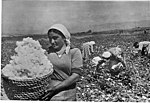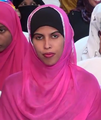A headscarf is a scarf covering most or all of the top of a person's, usually women's, hair and head, leaving the face uncovered. A headscarf is formed of a triangular cloth or a square cloth folded into a triangle, with which the head is covered.[1]


Purposes

Headscarves may be worn for a variety of purposes, such as protection of the head or hair from rain, wind, dirt, cold, warmth, for sanitation, for fashion, recognition or social distinction; with religious significance, to hide baldness, out of modesty, or other forms of social convention.[2] Headscarves are now mainly worn for practical, cultural or religious reasons.
Until the latter 20th century,[3] headscarves were commonly worn by women in many parts of Europe, Southwestern Asia, North Africa, and the Americas, as well as some other parts of the world. In recent decades, headscarves, like hats, have fallen out of favor in Western culture. They are still, though, common in many rural areas of Eastern Europe as well as many areas of the Middle East and the Indian subcontinent.[4]
The Christian Bible, in 1 Corinthians 11:4–13, enjoins women to wear a head covering.[5] Among Anabaptist Christians, this often takes the form of a Kapp or hanging veil—being worn throughout the day.[6] For Eastern Orthodox Christians, headscarves are traditionally worn by women while attending the church, and historically, in the public as well. However, in certain localities, this has waned.[7][8][9]
A form of headscarf, known as the hijab, is often seen in Muslim countries and is born out of tradition. It is worn by some Muslim women who consider it to be a religious ordainment, and its style varies by culture.[10] Not all Muslims believe that the hijab in the context of head covering is a religious ordainment in the Quran.[11][12]
For fashion and ceremonial usage, the gele is a traditional headscarf of Yoruba women for fashionable purposes.
Religious use
Headscarves may specifically have a religious significance or function, or be expected as a matter of social custom, the two very often being confused.[citation needed]
Judaism
Judaism, under Halakhah (Jewish Law), promotes modest dress among women and men. Many married Orthodox Jewish women wear a headscarf (mitpahat or tichel), snood, turban, or shpitzel to cover their hair. The Tallit is commonly worn by Jewish men, especially for prayers, which they use to cover their heads in order to recite the blessings, although not all men do this. It also may not apply to the entire prayer service, sometimes only specific sections such as the Amidah. The Kohanim (priests) also cover their heads and shoulders with the tallit during the priestly blessing, so as to conform to Halakah which states that the hands of the priests should not be seen during this time as their mystical significance to the hand position.
Christianity


The Bible, in 1 Corinthians 11:4–13, instructs women to wear a head covering, while men are to pray and worship with their heads uncovered.[13][14] In the early Church, Christian head-covering with an opaque cloth veil was universally taught by the Church Fathers and practiced by Christian women.[15][3][16][17][18] The practice continues in many parts of the world, such as Romania, Russia, Ukraine, Ethiopia, India, Pakistan, and South Korea.[19]
The Early Church Father John Chrysostom (c. 347 – 407) delineated Saint Paul's teaching, explaining that Paul said a man praying with a head covering "dishonoureth his head", while Christian women should always wear a cloth head covering. Paul compared a woman not wearing a veil to her being shaven, which Chrysostom stated is "always dishonourable".[7][20]
The Church Fathers taught that because the hair of a woman has sexual potency, it should only be for her husband to see and covered the rest of the time.[21] To some extent, the covering of the head depended on where the woman was, but it was usual outside and on formal occasions, especially when praying at home and worshipping in church.[19][22] Certain styles of Christian head coverings were an indication of married status; the "matron's cap" is a general term for these.[13]
Many Anabaptist Christian women (Amish/Para-Amish, Schwarzenau Brethren, Bruderhof, Hutterites, River Brethren, Apostolic Christians, Charity Christians and Mennonites) wear their headscarf at all times, except when sleeping; these head coverings are usually in the form of a hanging veil or kapp.[23][6]
In countries with large Eastern Orthodox Christian population such as Romania[24] or Russia[25] headscarves and veils are used by Christian women in the Eastern Orthodox Church, Oriental Orthodox Church, Assyrian Church of the East, and Roman Catholic Church.[26][27] A few years back, all women in Russia who attended Divine Liturgy wore head-coverings. A woman having her head covered means that she honors the Lord. Head-coverings also symbolizes that a woman is married and that her husband is the head of the family. Little girls also have their heads covered when they go to Mass at church, not because they are married, but in order to honor the Lord. Today, young Russian Orthodox women and little girls still cover their heads when going to church, although it differs in style from those worn by women of older age (grandmothers).[citation needed]
The Roman Catholic Church required all women to wear a head covering over their hair in church until the 1980s; in Spain, these take the form of the mantilla. Women meeting the Pope in formal audiences are still expected to wear them. Martin Luther, the German Reformer, as well as John Calvin, a major figure in the Reformed Churches, also expected women to cover their heads in church, as did John Wesley, the founder of the Methodist Churches.[28]
In many rural areas, women, especially widows, continue to observe the traditional Christian custom of head-covering, especially in the Mediterranean, as well as in eastern and southern Europe; in South Asia, it is common for Christian women to wear a head covering called a dupatta.[29][19] At times the styles of covering using simple cloth became very elaborate, with complicated layers and folding, held in place with hair pins. Among the many terms for head-coverings made of flexible cloth are wimple, hennin, kerchief, gable hood, as well as light hats, mob caps and bonnets.[citation needed]Some English speakers use the word "babushka" (the word for "grandma" in Russian: ) to indicate a headscarf tied below the chin, as still commonly worn in rural parts of Europe. In many parts of Europe, headscarves are used mainly[citation needed] by elderly women, and this led to the use of the term "babushka", an East Slavic word meaning "grandmother". Some types of head coverings that Russian women wear are: circlet, veil, and wimple.
Islam
Islam promotes modest dress among men and women. According to some, it is the "khimar"[30][31] mentioned in the Quran. Many of these garments cover the hair, ears and throat, but do not cover the face. Not all Muslims believe that the hijab in the context of head-covering is a religious ordainment in the Quran.[11][12]
The keffiyeh is commonly used by Muslims in Middle Eastern countries.[32]
Headscarves and veils are used by some Muslim women and girls, so that no one has the right to expose her beauty but except her Mahrams.[33] For women, the Muslim religious dress varies, and various cultures include hijab, burqa, chador, niqab, dupatta, or other types of hijab, while others reject all of these dress codes. The religion prescribes modest behaviour or dress in general.[34]
Sikhism
Young Sikhs often wear a cloth wrapping to cover their hair, before moving on to the dastar. Older Sikhs may wear them as an under-turban.[citation needed]
Use while working



Practical reasons for headscarf use at work include protection from bad weather and protection against industrial contamination, for example in dusty and oily environments. A headscarf can ensure that the hair does not interfere with the work and get caught-up in machinery since long hair can get into rotating parts of machines, so this is avoided either by means of a suitable head covering like a cap, hairnet or kerchief; cutting the hair short; or by putting on a headscarf. Hygiene also requires wearing a head cover at some workplaces, for example in kitchens and hospitals. Such usage has gone on since about 1900, when women's use of mob caps and Dutch bonnets declined.
Workers wore them at work to protect their hair from dirt. Farmers used them to see off the weather and dirt. Soviet labour units of the 1930s and 1940s wore them as part of their uniform (where uniforms were available). This habit was common until about the 1950s in the West for farmers and 1960s factory workers, and 1970s in the former USSR for farmers and factory workers.
In popular culture
In the modern era, persons may choose to wear a headscarf for religious, moral, or practical reasons.
Hilda Ogden, popular character from the UK soap opera Coronation Street portrayed by Jean Alexander, became famous throughout the nation for combining a headscarf with hair curlers. So famous was she that, in 1982, she came fourth behind the Queen Mother, Queen Elizabeth II, and Diana, Princess of Wales in a poll of the most recognisable women in Britain.[35]
Image gallery
- School girls in Herat, Afghanistan
- Oil on canvas painting by Vittore Ghislandi, called Fra Galgario
- Distribution of Communion at a Tridentine Mass, women typically wear a headcovering.
- A woman selling flowers. Egypt, 1906
- Assyrian Christian women wearing headcoverings and modest clothing praying in Mart Maryam Church in Urmia, Iran
- Girls dressed up for a parade wear matching yellow headscarves. 2009, New Orleans, Louisiana.
- A Jewish woman wearing a headwrap
- Woman with a headscarf in Gambia
- Egypt, 1935
- A headscarf for chefs; Los Angeles, 2007
- Three Turkish women wearing headscarves, 2003
- Laughing woman in Kuala Lumpur wearing a blue headscarf, 2008.
- A Malaysian girl wearing a headscarf, 2010.
- Women typical dress and headscarf; Nazaré, Portugal, 2006.
- Yoruba Women in Gele, a traditional headscarf (Iborun) of Yoruba ladies
- Salvadoran women wear distinctive regional veils for national celebrations.
- A young Somali woman in a traditional headscarf.
- A cancer patient in a head scarf after losing her hair due to Chemotherapy.
- An Afghan girl wears an Islamic style scarf at the International Women's Day celebration in Pajshir in 2008.
- A Chinese man with headscarf in his fashion costume.
- Scarved Moksha girls in traditional costumes.
- Amenhotep II in a Nemes headcloth.
- The Molokans (Russian: Молока́не) are a religious sect, among Russian peasants (serfs), who broke away from the Russian Orthodox Church in the 1550s. Molokans denied the Czar's divine right to rule and rejected icons.
- An early 19th-century Russian silk embroidered headscarf.[36]
See also
References
Further reading
- Anderson, Cory A. (2013). The Ornament of a Spirit: Exploring the Reasons Covering Styles Change. Stoneboro: Ridgeway Publishing.
- Anderson, Cory; Anderson, Jennifer (2019). Fitted to Holiness: How Modesty is Achieved and Compromised among the Plain People. Millersburg: Acorn Publishing.
- Bercot, David (2012). What the Early Christians Believed About the Head Covering. Amberson: Scroll Publishing Co.
- Bercot, David (1992). Common Sense: A New Approach to Understanding Scripture. Amberson: Scroll Publishing Co. ISBN 9780924722066.
- Ruth, Merle (2022). The Significance of the Christian Woman's Veiling. Harrisonburg: Christian Light Publications.
- Shank, Tom (1992). "…Let Her Be Veiled.": An in-depth study of 1 Corinthians 11:1-16. Eureka: Torch Publications.
- Williams, Paul K. (2005). The Head Coverings of I Corinthians 11 (PDF). Archived (PDF) from the original on 28 December 2018.
External links
 Media related to Headscarves at Wikimedia Commons
Media related to Headscarves at Wikimedia Commons


























